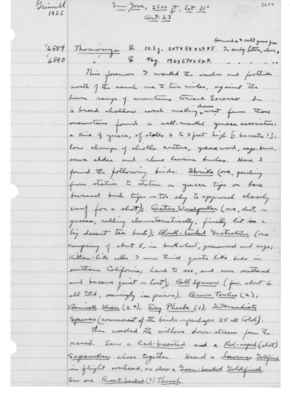Pages That Mention Shrike
1925: Joseph Grinnell's field notes
S3 Page 53
Collector: Grinnell - 1925 Location: San Jose, 2500 ft., Lat. 31 degrees Date: October 19, 1925 Page Number: 2596
There was a little seepage there, and some rainwater in granite bowls in the stream-course. Large numbers of Valley Quail centered there. The following are the birds I saw, by individuals, from memory; but there were so few, I believe I am close & correct. Red-shafted Flicker (2); San Lucas Flycatcher (1, shot); Calif Jay (10±) Audubon Warbler (16±); Ruby-crown Kinglet (1); Spotted Towhee (5); Brown Towhee (4); Green-backed Goldfinch (1); Lawrence Goldfinch (1, seen and heard in flight overhead); Intermediate Sparrow (20±); Bell Sparrow (2); Calif. Thrashers (3); Shrike (one, very shy, seen and heard repeatedly, but refused to be stalked); Bewick Wren (3); Rock Wren (2); Valley Quail (40±). Horseback is a good way of taking a census, as it increases the range of vision, though chances of hearing high-pitched voices are less because of the squeakings of the saddle, rattle of the bit-chain, etc. I rather think that a foot in most productive, as a person can stop instantly, in perfect quiet, and listen and look; while the horse takes time to come to a standstill and even then fidgets. Of mammals, I saw one Jack Rabbit, and one Bush Rabbit, the latter, as usual in Adenostoma bush. Large bare areas in the mesa, adjacent to sage-bush and juniper, showed great amounts of Dipodomys sign — of the same sort as where I am trapping, near the ranch; this is of the heermanni or paramintinus kind and not of the agilis brand, it seems to me.
S3 Page 59
S3 Page 59
Collector: Grinnell - 1925 Location: San Jose, 2500 ft., lat. 31° Date: Oct. 23 Page Number: 2602
6589 Thomomys (female sign) 123g. 207 x 58 x 29 x 5. In sandy bottom, where bermuda & salt grass grow. 6590 “ (female sign) 96g. 190 x 57 x 25 x 4. “ “ “ “ “ “
This forenoon I worked the washes and foothills north of the ranch one to two miles, against the lower range of mountains toward Socorro. In a broad shallow wash down west from those mountains found a well-marked yucca association: a kind of yucca, of stalks 6 to 8 feet high [= buccata?]; low clumps of cholla cactus, greasewood, sage-brush, some alder and rhus laurina bushes. Here I found the following birds: Shrike (one, perching from station to station in yucca tips on bare burned bush tips - too shy to approach closely enuf for a shot); Cactus Woodpecker(one, shot, on yuccas, calling characteristically, finally lit in a big desert tea bush); Black-tailed Gnatcatcher (one company of about 5, in buckwheat, greasewood and sage; kitten-like calls I now think quite like birds in Southern California; hard to see, and soon scattered and became quiet - lost); Ball Sparrow (few, about 6 all told, seemingly in pairs); Brown Towhee (2); Bewick Wren (2+); Say Phoebe (1); Intermediate Sparrow (commonest of the birds - perhaps all 25 told).
Then worked the willows down-stream from the ranch. Saw a Red-breasted and a Red-naped (shot) Sapsucker close together. Heard a Lawrence Goldfinch in flight overhead, as also a Green-backed Goldfinch. Saw one Russet-backed (?) Thrush.

